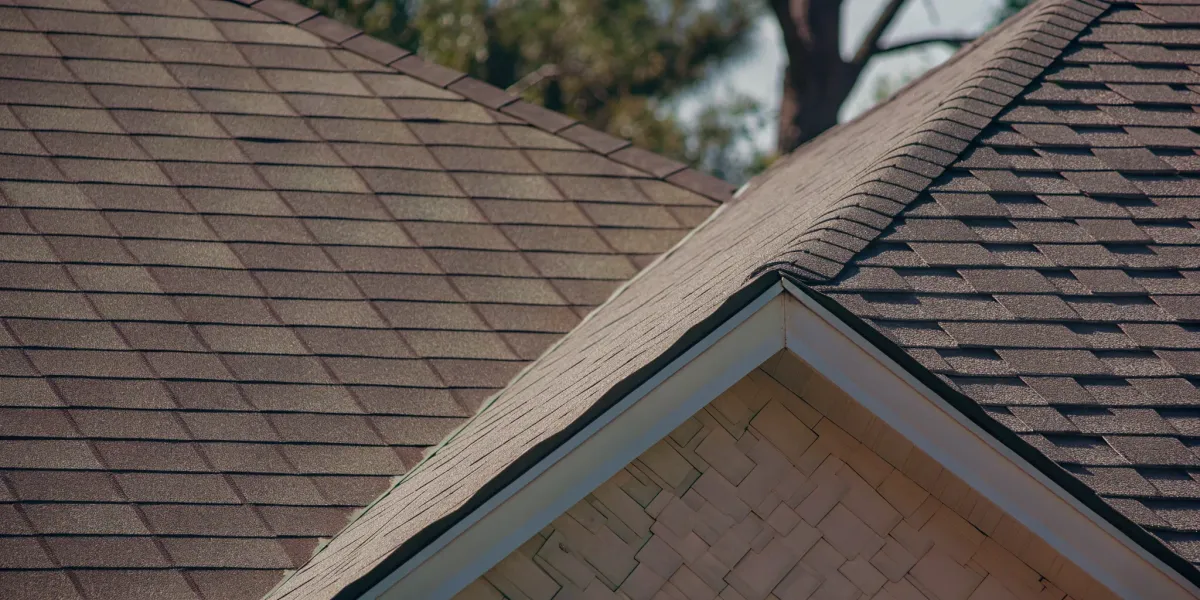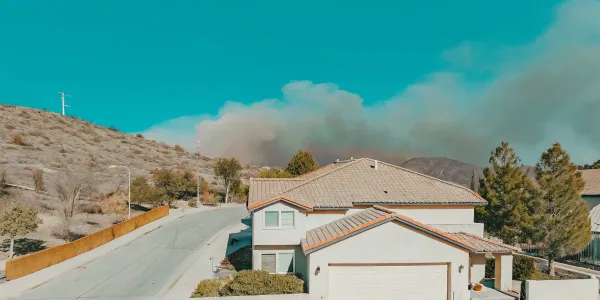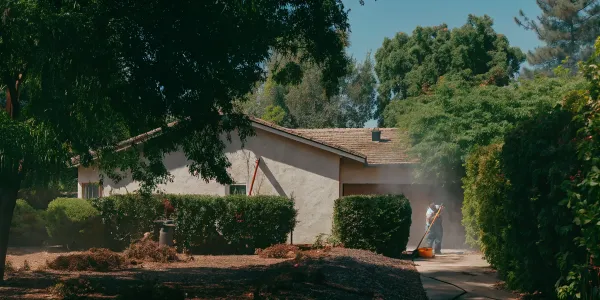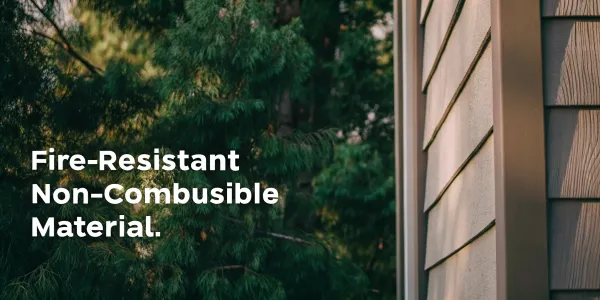Synthetic vs. Asphalt Shingles: A Homeowner's Guide
Get the facts on synthetic shingles vs asphalt shingles. Compare fire safety, cost, durability, and insurance impact to choose the best roof for your home.

For homeowners in high-risk areas, a letter from your insurance company can change everything. Whether it’s a non-renewal notice or a staggering premium increase, the message is clear: insurers are scrutinizing your home’s wildfire resilience like never before. Your roof is their number one concern. It’s your home’s largest, most exposed surface and its primary defense against wind-blown embers. This is where the debate over synthetic shingles vs asphalt shingles becomes more than a style choice—it’s a critical financial and safety decision. Understanding how each material performs, what it costs long-term, and how insurers view it is the key to protecting your property and keeping it insurable.
Key Takeaways
- A Class A Fire Rating is Non-Negotiable: For safety and insurability in high-risk areas, a Class A rating is essential. While some asphalt shingles qualify, synthetic composite shingles are often engineered for superior fire resistance, a feature that insurers value highly.
- Look Beyond the Initial Price Tag: Synthetic shingles cost more upfront, but they are a smarter long-term investment. Their 40-50 year lifespan, minimal maintenance, and potential for insurance discounts often result in a lower total cost of ownership compared to asphalt.
- Choose Materials That Withstand More Than Fire: Your roof faces wind, hail, and intense sun. Synthetic shingles offer superior durability, resisting damage from severe weather and UV rays far better than traditional asphalt, which means fewer repairs and more reliable protection year-round.
What Are Synthetic and Asphalt Shingles?
When you’re thinking about protecting your home, your roof is the first line of defense. The shingles you choose play a huge role not just in curb appeal, but in how well your home stands up to weather, debris, and—most importantly—wildfire. Two of the most common options you’ll encounter are synthetic and asphalt shingles. While they might look similar from the ground, they’re built differently and offer distinct advantages. Understanding these differences is the first step toward making a choice that keeps your home and family safe.
How They're Made
The core difference between these two shingles starts with their basic ingredients. Synthetic shingles are a modern innovation, engineered from a variety of materials like plastic, rubber, and polymer composites. Many brands use recycled materials in their manufacturing process, turning post-consumer waste into a durable roofing product.
Asphalt shingles, on the other hand, have been the go-to choice for decades. Their construction is more straightforward. They start with a base mat, typically made of fiberglass for strength, which is then coated in waterproof asphalt. The final touch is a top layer of mineral granules that provide color and help protect the shingle from sun damage.
Key Construction Differences
Think of synthetic shingles, often called composite shingles, as a high-tech blend. They are manufactured to mimic the look of more expensive materials like natural slate or wood shakes but with added durability and lower maintenance. Because they are molded from a mix of plastics and polymers, they are solid all the way through, which helps them resist impact and weathering.
Asphalt shingles are built in layers. This traditional construction has been refined over the years to create a reliable and cost-effective roofing material. The fiberglass mat provides the structure, the asphalt provides the waterproofing, and the granules on top shield the asphalt from UV rays. This layered approach has made them a staple in residential roofing for generations.
Understanding Fire Safety Ratings
For homeowners in wildfire-prone areas, this is where you need to pay close attention. Roofing materials are tested and assigned a fire rating: Class A, B, or C. A Class A rating is the highest possible, meaning the material is effective against severe fire exposure.
Many modern synthetic shingles are engineered specifically for fire resistance and easily achieve a Class A rating. Their polymer-based composition doesn't ignite easily and can help prevent embers from burning through your roof deck. But that doesn't mean asphalt is out of the running. Most high-quality asphalt shingles on the market today are also Class A fire-rated. They are designed to withstand direct flame exposure for a significant period, giving your home crucial protection.
How Do They Perform Under Pressure?
Your roof is your home’s first line of defense against everything from a summer hailstorm to a stray ember. When you live in an area with serious weather or wildfire risk, the material you choose isn't just about looks—it's about resilience. Both asphalt and synthetic shingles are designed to protect your home, but they handle stress very differently. Understanding these differences is key to choosing a roof that gives you peace of mind when the pressure is on, whether that’s from high winds, intense sun, or the threat of fire. Let's break down how each material holds up when it matters most.
Standing Up to Weather and Debris
When a storm rolls in, you want a roof that can take a punch. Standard asphalt shingles are typically rated to handle winds up to 90 miles per hour, which covers most weather events. However, in areas prone to more extreme conditions, that might not be enough. This is where synthetic shingles show their strength. Made from durable polymers, composite shingles can withstand winds from 110 to 190 miles per hour. They are also engineered to better resist damage from hail and flying debris, which is a critical advantage during severe storms. For homeowners in high-wind areas, that extra durability can be the difference between a minor repair and a major replacement.
Tolerance for Extreme Heat
Constant exposure to the sun can take a toll on any roof, causing materials to break down and become brittle over time. Asphalt shingles, with their granular surface, can absorb a lot of heat and are susceptible to UV degradation. Synthetic shingles, on the other hand, are generally better at resisting UV rays. This helps them maintain their structural integrity and color for longer, even in relentlessly sunny climates. This superior heat tolerance not only contributes to a longer lifespan but can also help keep your home’s temperature more stable, potentially reducing the load on your air conditioning during hot summer months.
Which Offers Better Wildfire Protection?
For anyone living in a wildfire-prone area, this is the most important question. The best defense against embers is a roof with a Class A fire rating—the highest level of fire resistance available for residential roofing. While some asphalt shingles can achieve this rating, many synthetic options are manufactured to meet this standard from the start. Class A fire-rated roofing products, including many composite shingles, are tested to withstand severe fire exposure, making them a crucial component of a fire-resilient home. Choosing a Class A roof is one of the most effective steps you can take to harden your home and protect it from wildfire.
Which One Lasts Longer?
A new roof is a major investment, so you want it to last as long as possible. Here, the difference between the two materials is significant. A standard asphalt shingle roof typically has a lifespan of 20 to 30 years, depending on the climate and quality of the shingle. Synthetic composite shingles, however, are built for the long haul. Thanks to their durable construction and resistance to weather and UV damage, composite shingles last much longer, with a typical lifespan of 40 to 50 years. While they cost more upfront, their longevity means you may never have to replace your roof again, making them a sound long-term investment in your home’s protection.
What's the Real Cost?
When you’re deciding on a new roof, the price tag is a major factor. But the true cost goes far beyond the initial installation. You have to consider maintenance, energy bills, and even how your choice might affect your home insurance—especially if you live in a wildfire-prone area. A roof is a long-term investment in your home’s safety and value, so it’s important to look at the complete financial picture before making a decision.
Upfront Installation Costs
There’s no getting around it: synthetic shingles have a higher upfront cost. In fact, you can expect composite shingles to cost about three to four times more than standard architectural asphalt shingles. This initial investment can be significant, but it reflects the advanced materials and complex manufacturing process required to create a more durable, fire-resistant product. While asphalt is the more budget-friendly option at the outset, it’s just one piece of the puzzle when calculating the total cost of ownership over the life of your roof.
Long-Term Maintenance and Repairs
This is where the cost equation starts to shift. Asphalt shingles require more attention over their lifespan. You’ll need to plan for regular checks and repairs, like fixing shingles that have blown off in a storm or removing moss and algae growth to prevent damage. In contrast, synthetic shingles need very little care. Their durable composition resists cracking, warping, and impact, meaning you’ll spend less time and money on upkeep over the years, which contributes to a lower overall cost.
How They Affect Your Energy Bills
Your roof plays a big role in your home's insulation and energy consumption. Many composite shingles are designed to be more energy-efficient, with some featuring cool-roof technology that reflects solar heat. This can help keep your attic and home cooler during hot summer months, reducing the strain on your air conditioning system and potentially lowering your monthly energy bills. While standard asphalt shingles can also come in lighter, more reflective colors, synthetics often have a performance edge in this category, offering another way to recoup the initial investment over time.
Can Your Shingles Lower Your Insurance Premiums?
For homeowners in high-risk fire zones, this is a critical question. The answer is often yes. Installing a Class A fire-rated roof is one of the most impactful steps you can take to harden your home against wildfire. Many insurers recognize fire-resistant construction with lower rates or discounts because it reduces their risk. In a tight insurance market like California’s, having a fire-resistant roof can sometimes be the deciding factor in whether you can get or keep your coverage at all, making it an essential part of your financial and safety planning.
The Better Long-Term Investment
When you add everything up, the more expensive option can end up being the smarter financial choice. While synthetic shingles cost more to install, their impressive lifespan of 30 to 50 years or more means you won't have to replace your roof as often. Combine that longevity with minimal maintenance costs, potential energy savings, and better insurability, and the long-term value becomes clear. It’s an investment in durability and peace of mind that can save you money over many years.
What to Know About Installation and Upkeep
Choosing a new roof is a major investment that goes far beyond the initial price tag. How your shingles are installed and the amount of work they require over their lifespan will directly impact your budget, your time, and your home's safety. Understanding the differences in installation complexity and long-term upkeep is key to making a decision you’ll be happy with for decades. Let’s break down what you can expect from both synthetic and asphalt shingles once you’ve made your choice.
Why Professional Installation Matters
While it can be tempting to save money with a DIY approach, roofing is a job best left to experienced professionals. This is especially true for synthetic composite shingles, which are often heavier and more complex to install than their asphalt counterparts. Your roof may even need extra structural support to handle the weight. A proper installation by a certified roofing contractor ensures your roof performs as designed and, just as importantly, keeps your manufacturer's warranty intact. A shoddy installation can lead to leaks, premature failure, and a voided warranty, leaving you unprotected when you need it most.
What Regular Maintenance Looks Like
Your roof’s maintenance needs will largely depend on the material you choose. Asphalt shingles typically require more hands-on attention. You’ll need to perform regular checks for cracked, curling, or blown-off shingles, especially after heavy wind or storms. They are also more prone to moss and algae growth, which can trap moisture and degrade the shingles over time. In contrast, synthetic shingles are designed for durability and require very little maintenance. Because they are built to resist mold, algae, and impact damage, you can spend less time worrying about upkeep and more time enjoying your home.
Common Problems and How to Fix Them
Over time, all roofs face wear and tear, but some materials hold up better than others. Asphalt shingles are susceptible to damage from a variety of sources. Strong winds can lift and tear them, hail can leave dents and cracks, and even foot traffic during an inspection can dislodge their protective granules. Polymer composite shingles, on the other hand, are engineered to be much stronger. Their robust construction makes them highly resistant to tearing, cracking, and impact, offering a more reliable shield against the elements and giving you greater peace of mind.
What to Expect for Repairs
No roof is completely indestructible, so it’s wise to consider the repair process. If an asphalt shingle is damaged, repairs are usually straightforward and relatively inexpensive. Most professional roofers are familiar with the material, and finding a matching shingle is often simple. While synthetic shingles are far less likely to need repairs, fixing them can be more involved if damage does occur. The process may require a roofer with specialized skills, and the materials can be more costly. It’s a trade-off: more frequent but simpler repairs with asphalt versus rare but potentially more complex repairs with synthetics.
How Will They Look on Your Home?
A roof is a major part of your home's curb appeal, but you shouldn't have to sacrifice style for safety. Both synthetic and asphalt shingles offer a variety of looks to complement your home, though they excel in different areas. Understanding the aesthetic differences is key to choosing a material that fits your vision and protects your property. Whether you prioritize a specific architectural look or a wide color selection, there’s a fire-resistant option that will work for you.
Available Styles and Textures
If you love the appearance of high-end roofing but not the cost or fire risk, synthetic shingles are a fantastic choice. They are expertly crafted to look like expensive materials such as natural slate tiles or classic cedar shakes, providing rich textures and dimension that can elevate your home's entire look. Asphalt shingles also come in a range of styles. You can choose from basic, flat 3-tab shingles for a clean, traditional appearance or select thicker, more decorative architectural shingles that add depth and character to your roofline.
Finding the Right Color
Finding the perfect color to match your home’s siding, trim, and shutters is crucial for a cohesive design. Asphalt shingles are well-known for their extensive color palette, offering everything from neutral grays and browns to bolder greens, blues, and reds. This wide selection makes it easy to find a shade that fits your personal style. Synthetic shingles also come in various colors, though the options are often designed to realistically imitate slate or wood. You’ll find a range of earthy tones for wood-look shingles and varied grays for those mimicking natural stone.
Matching Your Home's Architecture
The right shingle can perfectly complement your home's architectural style. Because composite shingles offer a high-end, luxurious look, they are an excellent match for homes where aesthetics are a top priority, from historic Tudors to rustic mountain lodges. They deliver the authentic appearance of slate or wood without the associated maintenance or fire hazard. Asphalt shingles are incredibly versatile and work well with nearly any home design, including modern, ranch, and colonial styles. Their widespread popularity means you can easily find a style and color that feels right at home on your house.
Customization Options
Beyond color and texture, it’s important to consider how your choice aligns with your safety goals. Many synthetic shingles achieve a Class A fire rating—the highest possible—giving you peace of mind without compromising on appearance. This means you can get the customized look of wood shakes while having excellent resistance to fire. While asphalt shingles also offer customization, the primary benefit of synthetics is getting that premium, tailored aesthetic combined with top-tier fire performance. This versatility allows you to create a safe, beautiful home that meets both your design preferences and your insurer's requirements.
Which Shingle Is More Eco-Friendly?
When you’re focused on protecting your home from fire, the environmental impact of your roofing material might not be the first thing on your mind. But the two are often connected. A durable, long-lasting roof is inherently less wasteful than one that needs frequent replacement. And materials designed for energy efficiency can lower your home's carbon footprint while also making it more resilient. Let's look at how synthetic and asphalt shingles compare from an environmental perspective.
Comparing Their Carbon Footprint
The environmental impact of a shingle begins long before it reaches your roof. Asphalt shingles are a petroleum-based product, meaning their production is tied to the fossil fuel industry. The manufacturing process is energy-intensive. In contrast, many synthetic shingles are made from recycled rubber and plastics, giving a second life to materials that would otherwise end up in a landfill. Because synthetic options are often lighter than traditional materials, they can also reduce transportation emissions on their journey from the factory to your home. This combination of recycled content and lower transport weight generally gives synthetic shingles a smaller carbon footprint from the start.
Recycling and Sustainability
What happens to your roof at the end of its life is a major factor in its overall sustainability. While asphalt shingles can be recycled, the process is complex and recycling facilities are not available everywhere, meaning tons of old shingles end up in landfills each year. Synthetic shingles often have a better end-of-life story. Many are made from post-consumer recycled materials, such as plastic bottles and rubber tires. Some manufacturers even offer take-back programs to ensure their products are recycled into new shingles. This creates a more circular system, reducing waste and the need for virgin materials. Choosing a shingle made from recycled content is a practical way to support a more sustainable building industry.
How They Help Keep Your Home Cool
A roof’s color and material composition play a big role in your home's energy efficiency. Dark asphalt shingles absorb a significant amount of solar heat, transferring it into your attic and living spaces. This can force your air conditioning to work harder, driving up energy bills. Many synthetic shingles are available in "cool roof" colors designed to reflect more sunlight and absorb less heat. According to the Cool Roof Rating Council, a cool roof can lower roof temperatures by up to 50°F. This not only saves you money but also reduces strain on the electrical grid during peak summer hours, contributing to a more resilient community.
Where the Materials Come From
To understand the environmental difference, it helps to know what each shingle is made of. Asphalt shingles consist of a fiberglass mat coated in asphalt and topped with mineral granules. The key ingredient, asphalt, is a byproduct of crude oil refining. Synthetic shingles, on the other hand, are typically made from a composite blend of materials. These can include recycled plastics, rubber, polymers, and other additives that provide strength, color, and fire resistance. By using post-consumer materials, synthetic shingle manufacturers reduce reliance on virgin resources and divert waste from landfills, making them a more forward-thinking choice for an eco-conscious homeowner.
Meeting Safety Codes and Insurance Rules
Choosing a new roof is about more than just curb appeal or durability; it's also about meeting the strict requirements set by local governments and insurance companies. In wildfire-prone areas, your roofing material is one of the most critical components of your home's defense system. A fire-resistant roof can be the difference between a close call and a total loss. More than that, it’s often a non-negotiable factor for securing and maintaining homeowner's insurance. Understanding these rules is the first step toward making a smart, safe, and financially sound decision for your property. This section breaks down what you need to know about building codes, fire ratings, and insurer expectations before you invest in a new roof.
What Local Regulations Require
Before you pick out a shingle color, you need to check with your local building department. Many communities, especially those in designated high fire hazard areas, have specific building codes that dictate the type of roofing materials you can use. These regulations are designed to reduce the risk of structure-to-structure fire spread, protecting not just your home but your entire neighborhood. For example, codes often mandate a minimum fire-resistance level for new or replacement roofs. Failing to comply can result in fines and the costly task of redoing the work. Always confirm your local requirements to ensure your project is up to code from the start.
Meeting Fire Safety Standards
When it comes to fire safety, the most important term to know is "Class A." This is the highest fire rating a roofing material can receive, indicating it can withstand severe fire exposure. Both high-quality asphalt and synthetic shingles can achieve a Class A rating. Products with this rating, like composite shingles, metal, and tile, offer significant protection against wind-blown embers, which are a primary cause of home ignition during a wildfire. Many modern synthetic shingles are specifically engineered for fire resistance, providing the look of materials like wood shake without the associated fire risk. Choosing a Class A roof is one of the most effective home hardening actions you can take.
What Insurers Want to See
In today’s challenging insurance market, your roof can be a dealbreaker. Insurers are looking for clear evidence that you’ve taken steps to reduce your home’s wildfire risk. A Class A fire-rated roof is at the top of their list. Installing one can directly impact your ability to get or keep your policy and may even qualify you for discounts. Insurers see a fire-resistant roof as a sign of a lower-risk property, making them more willing to offer coverage. Documenting this upgrade is a key part of demonstrating your home's resilience and can be a central piece of your overall Wildfire Action Plan.
Understanding Your Warranty
A shingle's warranty primarily covers manufacturing defects and premature wear, but its fire rating is a crucial part of its performance promise. Most high-quality shingles on the market are Class A fire-rated, meaning they are tested to withstand direct flame exposure for a significant period before igniting. While the warranty won't cover damage from an actual wildfire, the rating itself tells you how the material is expected to perform under extreme heat. Always read the warranty details to understand what is covered, for how long, and what actions (like improper installation) could void it. This ensures you know exactly what protection you're paying for.
How to Choose the Right Shingle for Your Home
Making the right choice between synthetic and asphalt shingles comes down to balancing your immediate budget with your long-term goals for safety, value, and peace of mind. For homeowners in high-risk areas, this decision is about more than just curb appeal—it’s a critical part of your home's defense system. By looking at your specific climate, financial situation, and protection needs, you can find the roofing material that works best for you and your family.
Factor in Your Climate and Wildfire Risk
If you live in a wildfire-prone area, your roof is your home's first line of defense against airborne embers. This makes your choice of shingle incredibly important. Building codes in many high-risk zones now require Class A fire-rated roofing, which includes materials like composite shingles, metal, and tile. These products are designed to resist ignition and can help slow the spread of flames, giving you and first responders critical time during a wildfire. While asphalt shingles can also achieve a Class A rating, synthetic composite options often provide superior durability and resistance, offering a higher degree of protection when every second counts.
Weigh Your Budget
There’s no getting around it: cost is a major factor. Asphalt shingles are the most affordable roofing material on the market, making them an attractive option if your upfront budget is tight. However, it’s important to look at the bigger picture. Synthetic shingles can cost three to four times more than asphalt to install, but they are a long-term investment. Their extended lifespan and greater durability mean you’ll spend less on repairs and replacement over the decades. Think of it as paying more now to save much more later, especially when you factor in the potential costs of damage from a severe weather event or wildfire.
How Your Choice Affects Home Value
Your roof has a significant impact on your home’s resale value and insurability. A durable, attractive roof made from synthetic shingles can make your home stand out to potential buyers. More importantly, many insurance companies now recognize the value of fire-resistant construction. Installing a Class A-rated synthetic roof may help you secure lower premiums or even qualify for coverage when others can’t. In a tough insurance market, proving you’ve taken steps to harden your home can make all the difference, turning your investment into immediate and long-term financial savings.
Choosing for Long-Term Protection
Ultimately, your roof should protect your home and family for years to come. While a standard asphalt roof might last 15 to 20 years, synthetic shingles are built to endure, often lasting 50 years or more. This longevity means you won’t have to worry about a costly replacement anytime soon. More importantly, that durability translates directly to better protection. A roof that stands strong against heat, wind, and embers is a fundamental part of a resilient home. By choosing materials designed for long-term safety, you’re not just buying a roof—you’re investing in lasting security. Creating a personalized wildfire plan can help you identify this and other critical steps to safeguard your property.
Related Articles
- 5 Best Fire-Resistant Roofing Materials
- Class A Roofing 101: Everything You Need to Know
- Class A Roof Assembly: A Homeowner's Guide
Frequently Asked Questions
Which shingle is actually better for a home in a high-risk fire area? While high-quality versions of both asphalt and synthetic shingles can achieve a Class A fire rating, synthetic shingles generally offer a higher level of resilience. Their solid, polymer-based construction is engineered to better withstand extreme heat and resist ignition from wind-blown embers over the long term. Think of a Class A rating as the minimum requirement; a durable synthetic roof is an investment in a more robust defense.
The cost of synthetic shingles is so much higher. Is it really worth the investment? It’s true that the upfront cost is significant, but the long-term value is where synthetic shingles really pay off. They are built to last 40 to 50 years or more, which is often double the lifespan of an asphalt roof. When you add in their minimal maintenance needs, potential energy savings from cool-roof technology, and improved insurability, the total cost of ownership is often lower over time.
If I install a new Class A roof, will my insurance company guarantee my coverage? Unfortunately, no single home upgrade can guarantee insurance coverage in today's difficult market. However, installing a Class A fire-rated roof is one of the most impactful actions you can take. It demonstrates to insurers that you are serious about reducing your property's risk, which can be a critical factor in their decision to offer or renew a policy. It’s a foundational piece of making your home more defensible.
I love the look of a wood shake roof, but I know it's a huge fire hazard. Are there any safe alternatives? Yes, and this is exactly where synthetic shingles shine. They are expertly designed to replicate the beautiful, textured appearance of natural materials like cedar shakes and slate tiles. Because they are made from fire-resistant composite materials, they provide that high-end aesthetic with a Class A fire rating, giving you the look you want without compromising your family’s safety.
Do I need a professional to install these shingles, or can I do it myself? Roofing is a job best left to certified professionals, especially when dealing with synthetic materials. Proper installation is critical for ensuring the roof performs as it should and for keeping your manufacturer's warranty valid. Synthetic shingles can be heavier and require different techniques than asphalt, so hiring an experienced contractor ensures your investment is protected from day one.




